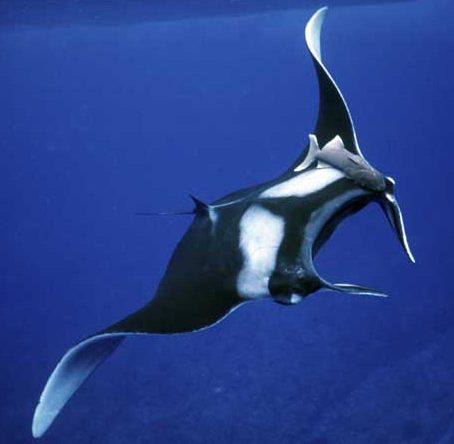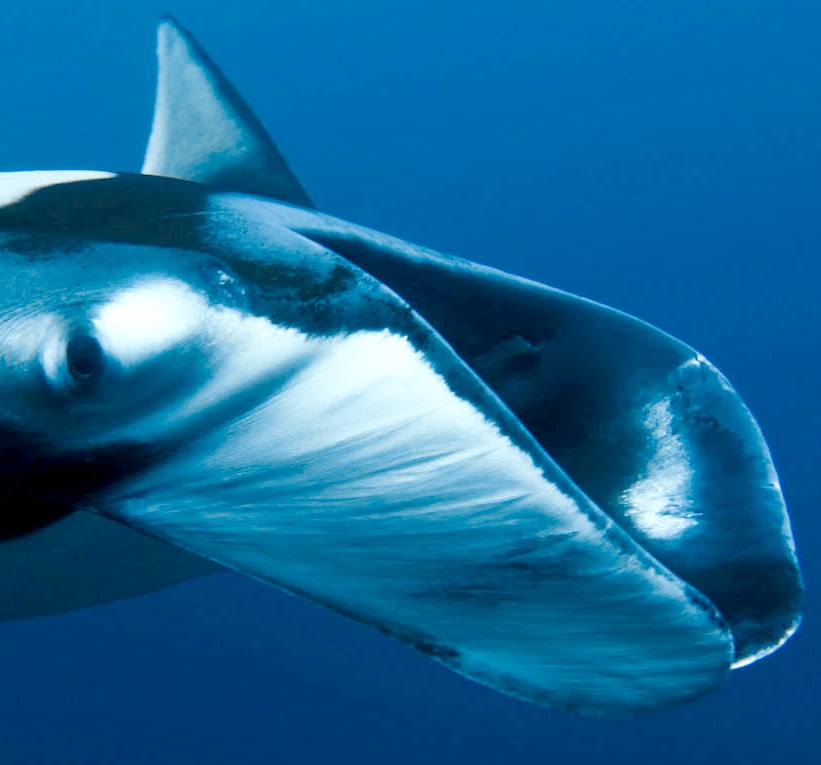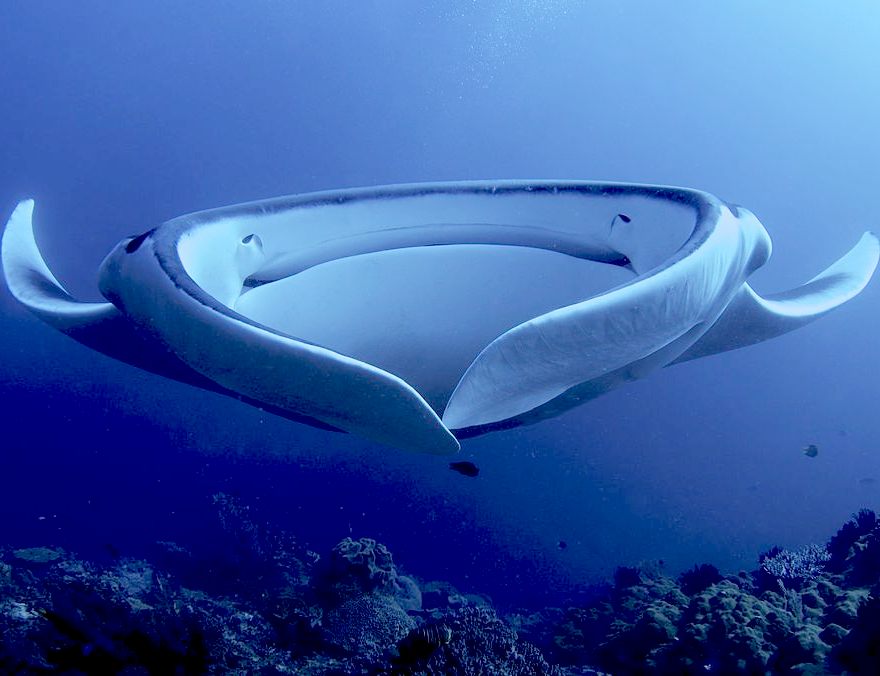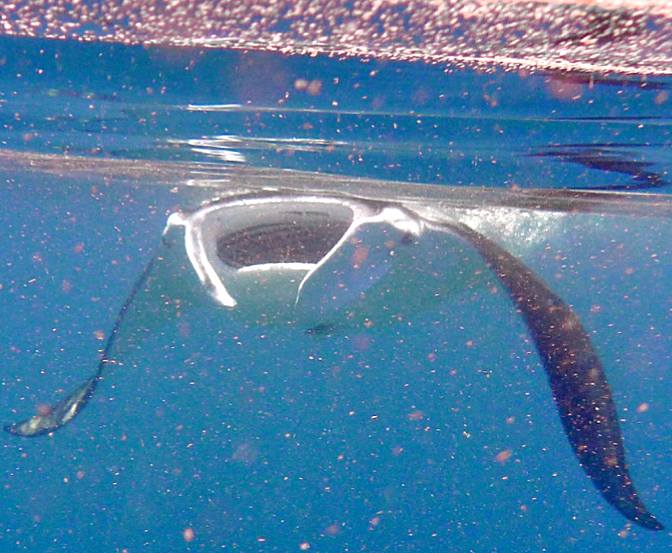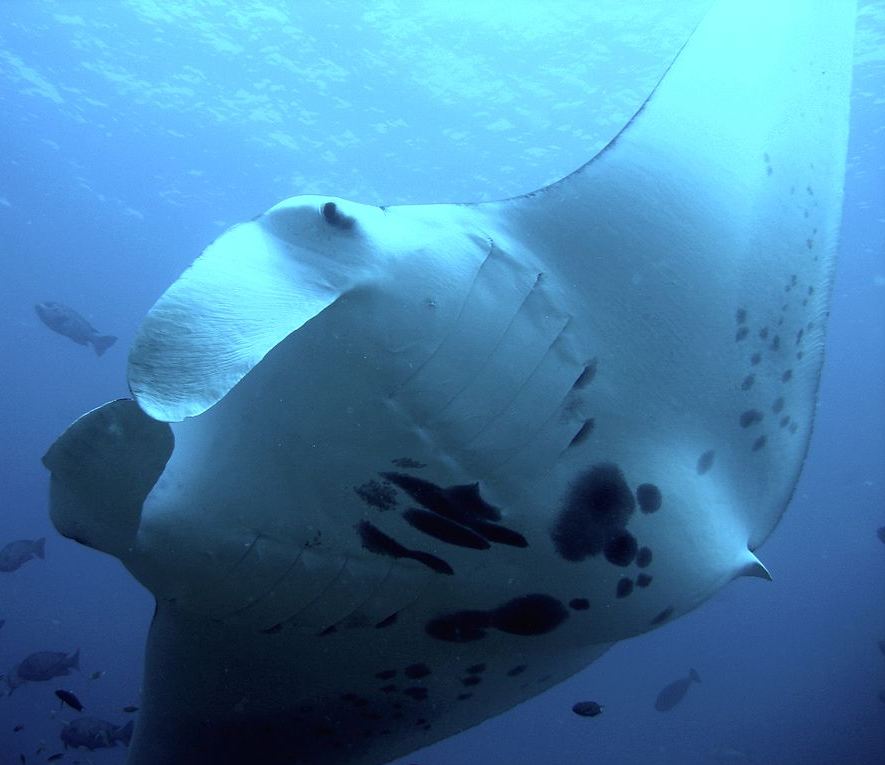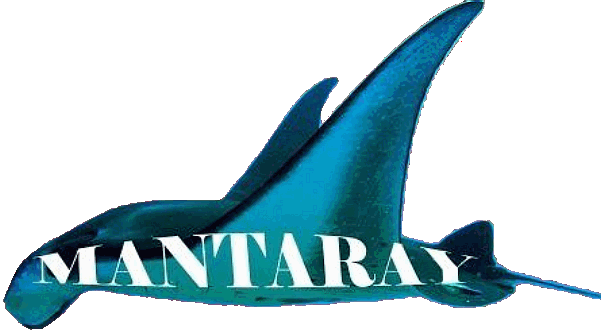|
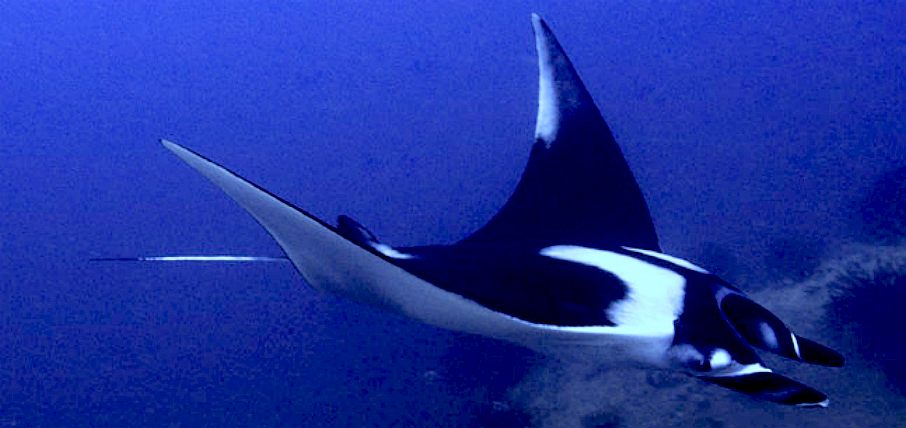
A
manta ray gliding down into the depths
MARINE ANIMATRONICS
The sea is full of weird creatures – none more strange than these lifelike spy robots used to film the private lives of dolphins for TV.
Each radio-controlled swimming model is fitted with HD cameras to capture unique footage of the unsuspecting marine mammals.
What might look like a colourful fish, squid, giant clam or turtle has at its heart a small submersible packed with high-tech equipment.
There are even motorised model dolphins, so realistic that the real ones – among the smartest animals on earth – happily accepted them into family groups.
In one sequence shot off the coast of Costa Rica in Central America, a 15mph Spy
Dolphin guided by experts in a high-speed inflatable
boat on the surface, easily kept pace with real-life spinner dolphins which can cover 250 miles a day. Then, when the spinners dived, the surveillance task was passed from Spy
Dolphin on the surface to
a superfast Spy Tuna submarine.

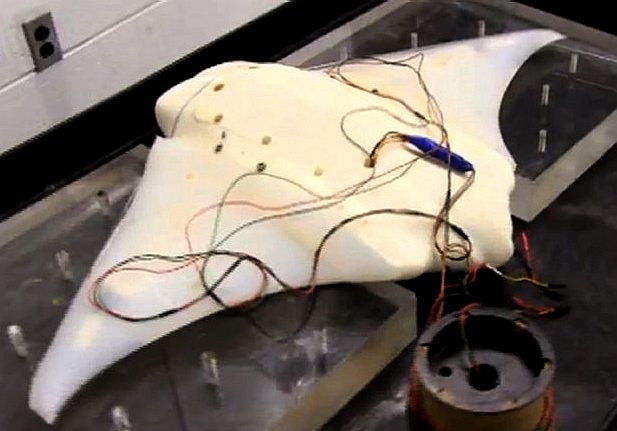
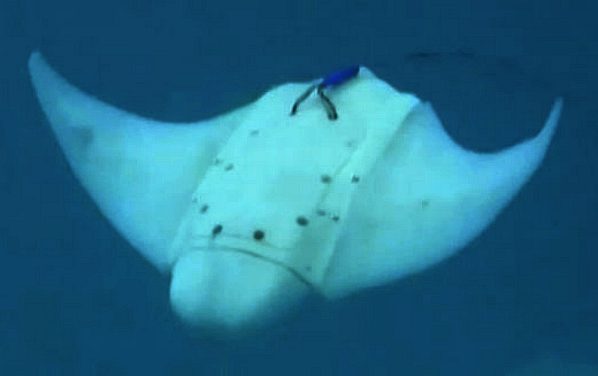
A
futuristic submarine with manta like wings and a real animatronic manta ray
robotic submariner on dry land and submerged.
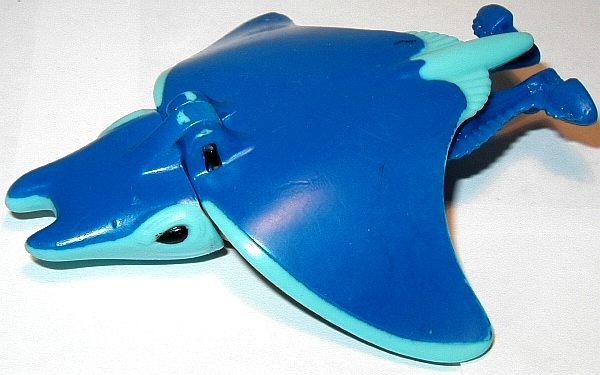

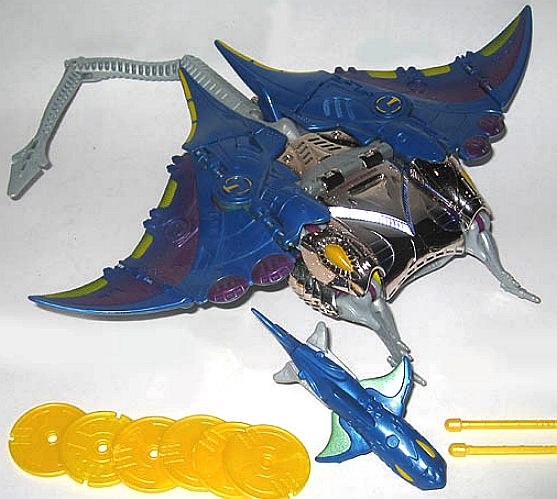
Toy
manta rays: that is a Beast from the wargaming Transformer type series and
the Depthcharge Transformer with robot shark.

A
stunning robotic manta ray machine from Think Artificial

AIR_RAY
- Inspired by the manta ray, but actually a helium filled balloon that is
shaped like the giant filter feeding fish. Festo is known as a top-notch automation hardware manufacturer, but their research division makes very artistic, bio-inspired robots as well.
Air_ray, modeled on the manta ray, is a remote-controlled hybrid construction consisting of a helium-filled ballonet and a beating wing drive. Its light design makes it possible for it to “swim” in the sea of air, boosted by helium, in a similar way to the manta ray in water.
Propulsion is achieved by a beating wing drive. The servo drive-controlled wing, which can move up and down,
utilizes the Fin Ray Effect® and is based on alternate pulling and pushing flanks connected via frames. When pressure is exerted on one flank, the geometrical structure curves automatically against the direction of the influencing force. A servo drive pulls the two flanks alternately in the longitudinal direction, thus moving the wing up and down.

AQUA_RAY
- is a remote-controlled fish driven by water hydraulics, the shape and movements of which have been based on the model of a manta ray.
The central drive and control unit of Aqua_ray takes the form of a Festo Fluidic Muscle. This is combined with the Fin Ray Effect
®, a design based on the functional anatomy of a fish’s fin that makes it possible to imitate the fin drive of the natural role model almost perfectly.
As the Aqua_ray can be manoeuvred extremely well, and can be operated both as a hydrostatic glider and with an active wing beat, substantial energy savings can be achieved. Thanks to its shape and method of movement, the Aqua_ray can be used in wide ranging areas of oceanography, without disrupting the natural environment.
SPECIFICATIONS:
Overall length: 61.5 cm - Dry chamber: 41.0 cm
- Overall width: 96.0 cm
Dry chamber: 31.0 cm - Height: 14.5 cm
- Weight: 10 kg approx
Materials Torso: fibreglass-reinforced plastic - Wings and tail: CURV®, water-jet
Skin: polyamide with elastan content
Drive units: Torcman brushless motor powers a 400l pump, which drives fluidic muscles from Festo, and two servo drive units for orientation of the wings
Power rating: 24 V, 10 Ah - Maximum speed: approx. 1.8 km/h
Minimum flight duration under full load: 30 min.
Sensors, diagnosis: 5 angular sensors, 2 force sensors, 1 potentiometer
Control: wireless digitally addressable 2-way communication
Computing power: 2 units with 10 MIPS at 40 MHz
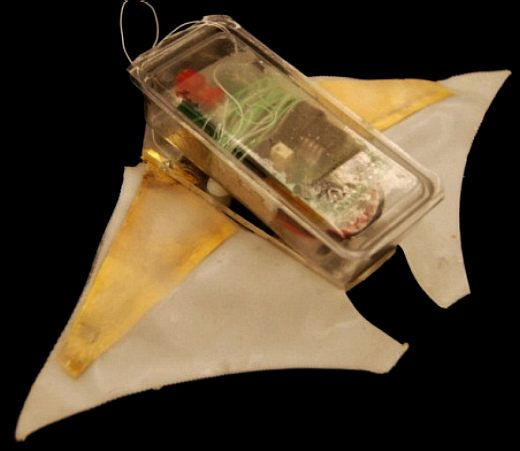
Electroactive polymers (EAPs), known as artificial muscles, can generate large deflections under an electrical stimulus (Bar-Cohen 2000, 2004). Due to the similarities with biological muscles, in terms of achievable stress and strain, EAPs have great potential to be used as actuators in bio-inspired robots, bio-medical devices, and micro/nano manipulation
systems, such as the manta ray animatronic above.
In the past, IPMC actuators have been used as a caudal fin in bio-inspired robotic fishes (Shahinpoor, 1992; Mojarrad & Shahinpoor, 1996; Tan et al, 2006; Guo et al, 2003), where the propulsive fin mimics the bending motion observed in many biological fishes. In the propulsion mechanism of rays, undulatory and oscillatory flapping motions of the pectoral fin play an important role in generating highly efficient propulsion and maneuvering (Rosenberger, 2001).
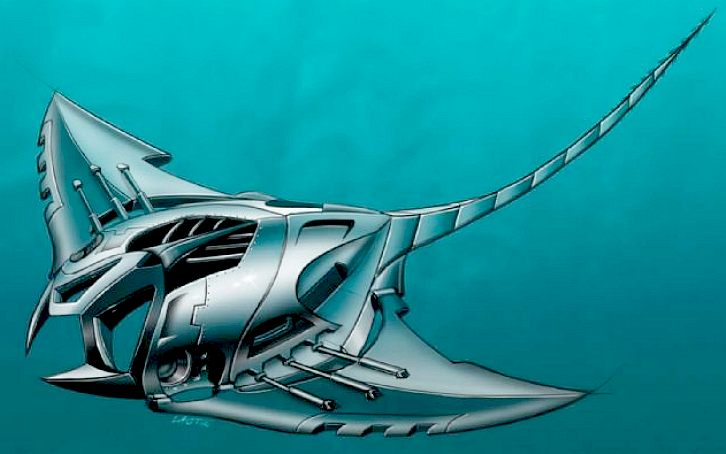
UNIVERSITY
OF VIRGINIA - JULY 2012
Engineers at the University of Virginia are designing and building a robot
submarine inspired by stingrays and manta rays.
Hilary Bart-Smith, associate professor of mechanical and aerospace engineering is quoted as saying (Batoid rays) "are wonderful examples of optimal engineering by nature. Rays are graceful swimmers, and can conserve energy by gliding for long distances."
We mostly get to see humanoid robots that walk on land and may or may not one day pose a threat to humans, but in recent years there have been many sub-surface
robots that come under the heading of animatronics. As in "animal" "electronics."
This Mantabot was designed to mimic the swimming style of a manta ray, and it does it’s job very well. It looks just like the real thing. Professor Bart-Smith explained that the robot is meant to explore the future of
bio-mechanical engineering by examining the unique way in which manta ray travels through water.
In other words it will help them to build even more realistic robots based on animals. Check out the video to see this creepy bot in action.
The engineers at Virginia have created a plastic and silicon prototype that's
moulded directly from a real cownose ray. They got the movements down by watching rays in the field and lab, and by dissecting the animals.
The robot can swim, turn, accelerate and glide with a near-silent flap of its wing-like pectoral fins. Researchers control the vehicle remotely by computer commands. Going forward, Professor Bart-Smith wants to achieve optimal silent propulsion with a minimum input of
energy.
NANYANG
TECHNOLOGICAL UNIVERSITY
They
are not the only group at it. Another manta ray robot has been designed by Prof K.H. Low and his
team-mate from Nanyang Technological University.
According
to their Youtube site that have two sensors onboard: one absolute pressure sensor which was calibrated to detect the depth of the robot
underwater, and one infrared sensor to detect obstacles in front of the robot,
so that the robot would turn when an obstacle is detected.
For the control method,
the team uses microprocessors to generate a sinusoidal wave using servo motors
and shaft position sensors on the motors. The shaft position would change according to the signal.
There is phase lag between motors. The fin is attached to the motors and flaps when motors adjust their shaft positions.
They can steer the robot by adjusting the amplitude and frequency of the wings.
EVOLOGICS
(MANTA RAY) SUBSEA GLIDER - 'AQUARAY'
Recent studies on the functional morphology of fins of fishes show a surprising biomechanical effect of the fin rays. The bionic implementations of these constructions led to shape-adaptive wing profiles and flow control devices. The functional principle has been patented as "Fin Ray Effect" and a line of products based on this effect is currently being developed.
Besides adaptive seat constructions, novel safe and form-locking grips are of particular interest. Creative applications in household technology, automation technology, keyhole surgery, and bionic robotics are also being developed.
As agile as a real manta ray, the rubbery, robotic acrobat is the handiwork of Rudolf Bannasch and Leif Kniese of bio-inspiration firm EvoLogics in Berlin,
Germany, and could kick-start a new generation of autonomous underwater vehicles.
Over the last decade AUVs, which are mostly propeller-driven, have been probing the oceans' vast depths without the need for human pilots. But although they can be customised for either fine
maneuvering or long-distance cruising, only rarely can they do both.
With a flap of its wings, Aqua ray can swim upside down, loop the loop, hover or turn on a dime.
The battery-powered Aqua Ray has the following specifications: Wing span: 1.5 - 3.5 m;
Maximum swimming velocity: 5 - 10 km/h; Cruising velocity: 2 - 5 km/h in economic
traveling, 0.5 - 1 km/h in gliding. Maximum depth of operation: 100 m (optionally full ocean depth)
and an operating time of up to 24 hours.
For
more information contact:
EvoLogics GmbH
Ackerstrasse 76
13355 Berlin
Germany
Tel. +49 30 4679 862-0
Fax. +49 30 4679 862-01
www.evologics.de
sales@evologics.de
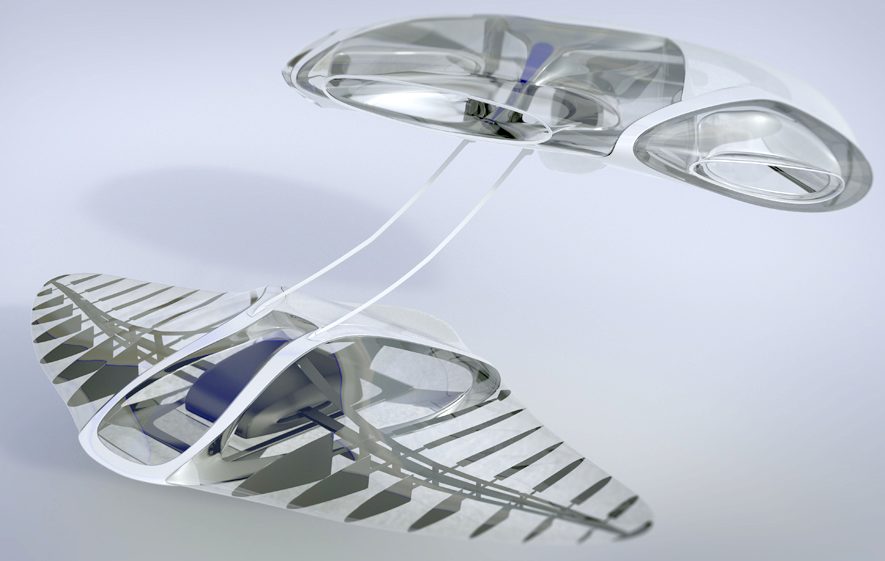
OLEG MASLOVSKIY'S OCEAN ROBOT CLEANING SYSTEM - This system is designed as
a compound unit of two robots: 1. manta ray drone and 2. cleaner drone. Both drones are interlinked, so
forming a unit that becomes the basis of a modular robotic system, in
actuality a fleet system. The mantra ray drone serves as the propulsion part of
the robotic unit and as a carrier of the cleaner drone. A plastic absorption engine is integrated within cleaner drone which collects bigger pieces of plastic debris floating in
the upper water column. There is no mention of the power source to operate
the system, nor transport or treatment of the plastic once it has been
harvested.

It
is proposed that the formation or patterns of a fleet are based on the irregular hexagonal module with
a maximum width span of 3 meters. Hexagonal modules can be arranged in a similar way as patterns based on conventional regular hexagonal grid.
Using this principle the designer claims that it is possible to arrange a swarm of drones effectively and quickly according to weather conditions and sea waves.
One point to consider here apart from the power source and other issues
mentioned above, it that a tethered, two-part robot operating in a close
formation fleet, may suffer from entanglement problems in use at sea when
waves and currents begin to take their toll. The design is though very
pleasing and we'd like to see how such a proposal might work, perhaps with
a working proof of concept prototype.
ABOUT
MANTA RAYS
Manta rays are large eagle rays belonging to the genus Manta. The larger species, M. birostris, reaches 7 m (23 ft 0 in) in width while the smaller, M. alfredi, reaches 5.5 m (18 ft 1 in). Both have triangular pectoral fins, horn-shaped cephalic fins and large, forward-facing mouths. They are classified among the Elasmobranchii
(sharks and rays) and are placed in the eagle ray family, Myliobatidae.
Mantas are found in temperate, subtropical and tropical waters. Both species are pelagic; M. birostris migrates across open oceans, singly or in groups, while M. alfredi tends to be resident and coastal. They are filter feeders and eat large quantities of zooplankton, which they swallow with their open mouths as they swim. Gestation lasts over a year, producing live pups. Mantas may visit cleaning stations for the removal of parasites. Like whales, they breach, for unknown reasons.
Both species are listed as vulnerable by the International Union for Conservation of Nature. Anthropogenic threats include pollution, entanglement in fishing nets, and direct harvesting for their gill rakers for use in Chinese medicine. Their slow reproductive rate exacerbates these threats. They are protected in international waters by the Convention on Migratory Species of Wild Animals, but are more vulnerable closer to shore. Areas where mantas congregate are popular with tourists. Only a few aquariums are large enough to house them. In general, these large fish are seldom seen and difficult to study.
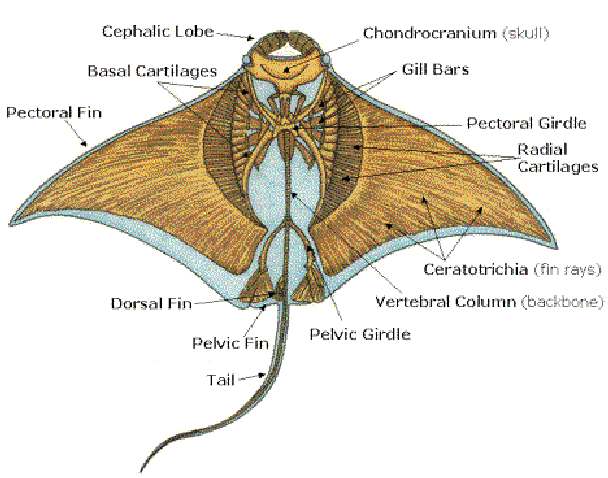
Manta
ray skeleton/anatomy
BIOLOGY
Manta rays are known for their large size, broad heads, triangular pectoral fins, and the horn-shaped cephalic fins located on either side of their mouths. They have horizontally flattened bodies with eyes on the sides of their heads (behind the cephalic fins) and gill slits on their ventral surfaces. Their tails lack skeletal support and are shorter than their disc-like bodies. The dorsal fins are small and at the base of the tail. The largest mantas can reach 1,350 kg (2,980 lb). In both species the width is approximately 2.2 times the length of the body; M. birostris reaches at least 7 m (23 ft) in width while M. alfredi reaches about 5.5 m (18 ft). Dorsally, mantas are typically black or dark in color with pale markings on their "shoulders". Ventrally, they are usually white or pale with distinctive dark markings by which individual mantas can be recognized. All black color morphs are known to exist. The skin is covered in mucus which protects it from infection.
The two species of manta differ in color patterns, dermal denticles, and dentition. M. birostris has more angular shoulder markings, larger ventral dark spots on the abdominal region, charcoal-colored ventral outlines on the pectoral fins and a dark colored mouth. The shoulder markings of M. alfredi are more rounded, while its ventral spots are located near the posterior end and between the gill slits, and the mouth is white or pale colored. The denticles have multiple cusps and overlap in M. birostris, while those of M. alfredi are evenly spaced and lack cusps. Both species have small square shaped teeth on the lower jaw but M. birostris also has enlarged teeth on the upper jaw. Unlike M. alfredi, M. birostris has a caudal spine near its dorsal fin.
Mantas move through the water by the wing-like movements of their pectoral fins, which drive water backwards. Their large mouths are rectangular, and face forward as opposed to other ray and skate species with downward-facing mouths. The spiracles typical of rays are vestigial, and mantas must swim continuously to keep oxygenated water passing over their gills. The cephalic fins are usually spiralled, but flatten during foraging. The fish's gill arches have pallets of pinkish-brown spongy tissue that collect food particles. Mantas track down prey using visual and olfactory senses. They have one of the highest brain-to-body mass ratios of all fish. Their brains have retia mirabilia which may serve to keep them warm. M. alfredi has been shown to dive to depths of over 400 m, while their relative Mobula tarapacana, which has a similar structure, dives to nearly 2000 m; the retia mirabilia probably serve to prevent their brains from being chilled during such dives into colder subsurface waters.
CONSERVATION ISSUES
The greatest threat to manta rays is over-fishing. M. birostris is not evenly distributed over the oceans, but is concentrated in areas that provide the food resources it requires, while M. alfredi is even more localized. Their distributions are thus fragmented, with little evidence of intermingling of subpopulations. Because of their long lifespans and low reproductive rate, overfishing can severely reduce local populations with little likelihood that individuals from elsewhere will replace them.
Both commercial and artisanal fisheries have targeted mantas for their meat and products. They are typically caught with nets, trawls and harpoons. Mantas were once captured by fisheries in
California and
Australia for their liver oil and skin; the latter were used as abrasives. Their flesh is edible and is consumed in some countries, but is unattractive compared to other fish. Demand for their gill rakers, the cartilaginous structures protecting the gills, has recently entered Chinese medicine. To fill the growing demand in Asia for gill rakers, targeted fisheries have developed in Philippines, Indonesia, Mozambique, Madagascar, India,
Pakistan,
Sri
Lanka, Brazil and Tanzania. Each year, thousands of manta rays, primarily M. birostris, are caught and killed purely for their gill rakers. A fisheries study in Sri Lanka and
India estimated that over 1000 were being sold in the country's fish markets each year. By comparison, M. birostris populations at most of the key aggregation sites around the world are estimated to have significantly fewer than 1000 individuals Targeted fisheries for manta rays in the Gulf of California, the west coast of Mexico, India, Sri Lanka, Indonesia, and the
Philippines have reduced populations in these areas dramatically.
Manta rays are subject to other anthropogenic threats. Because mantas must swim constantly to flush oxygen-rich water over their gills, they are vulnerable to entanglement and subsequent suffocation. Mantas cannot swim backwards and, because of their protruding cephalic fins, are prone to entanglement in fishing lines, nets, and even loose mooring lines. When snared, mantas often attempt to free themselves by somersaulting, tangling themselves further. Loose, trailing line can wrap around and cut its way into its flesh, resulting in irreversible injury. Similarly, mantas become entangled in gill nets designed for smaller fish. Some mantas are injured by collision with boats, especially in areas where they congregate and are easily observed. Other threats or factors that may affect manta numbers are
climate
change, tourism, pollution from oil
spills, and the ingestion of micro-plastics.
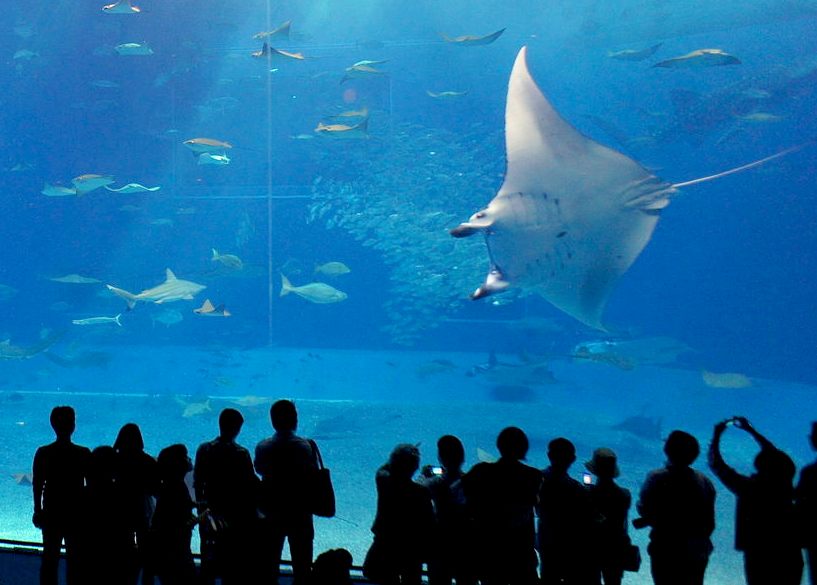
Due to their size, it is rare for mantas to be kept in captivity and few aquariums currently display them. One notable individual is "Nandi", a manta ray which was accidentally caught in shark nets off Durban, South Africa, in 2007. Rehabilitated and outgrowing her aquarium at uShaka Marine World, Nandi was moved to the larger Georgia Aquarium in August 2008, where she resides in its 23,848-m3 (6,300,000-US gal) "Ocean Voyager" exhibit. A second manta ray joined that aquarium's collection in September 2009, and a third was added in 2010.
The Atlantis resort on Paradise Island, Bahamas, hosted a manta named "Zeus" which was used as a research subject for three years until it was released in 2008. The Okinawa Churaumi Aquarium also houses manta rays in the "Kuroshio Sea" tank, one of the largest aquarium tanks in the world. The first manta ray birth in captivity took place there in 2007. Although this pup did not survive, the aquarium has since seen the birth of three more manta rays in 2008, 2009, and 2010.
TOURISM
Sites at which manta rays congregate attract tourists, and manta viewing generates substantial annual revenue for local communities. Tourist sites exist in the Bahamas, the Cayman Islands, Spain, the Fiji Islands, Thailand, Indonesia,
Hawaii, Western Australia and the Maldives. Mantas are popular because of their enormous size and because they are easily habituated to
humans. Scuba
divers may get a chance to watch mantas visiting cleaning stations and night dives enable viewers to see mantas feeding on plankton attracted by the lights.
Ray tourism benefits locals and visitors by raising awareness of natural resource management and educating them about the animals. It can also provide funds for research and conservation. Constant unregulated interactions with tourists can negatively affect the fish by disrupting ecological relationships and increasing disease transmission. At Bora Bora, an excessive number of swimmers, boaters and jet skiers caused the local manta ray population to abandon the area.
In 2014, Indonesia has brought in a fishing and export ban as it has realized that manta ray tourism is more economically beneficial than allowing the fish to be killed. A dead manta is worth $40 to $500 while manta ray tourism can bring in $1 million during the life of a single manta ray. Indonesia has 2.2 million square miles of ocean and this is now the world's largest sanctuary for manta rays.
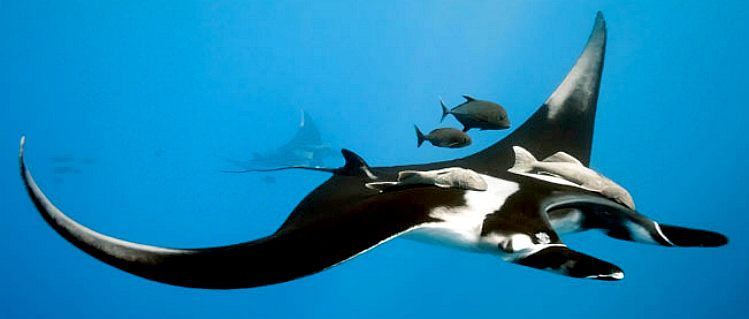
THREATENED RAYS
Threatened rays are those vulnerable to endangerment (extinction) in the near future. The International Union for Conservation of Nature (IUCN) is the world’s oldest global environmental organization. It evaluates threatened species, and treats threatened species not as a single category, but as a group of three categories, depending on the degree to which they are threatened.
The term threatened strictly refers to these three categories (critically endangered, endangered and vulnerable), while vulnerable is used to refer to the least at risk of these categories. The terms can be used somewhat interchangeably, as all vulnerable species are threatened, all endangered species are vulnerable and threatened, and all critically endangered species are endangered, vulnerable and threatened. Threatened species are also referred to as a red-listed species, as they are listed in the IUCN Red List of Threatened Species.
Together rays and sharks make up the class of modern cartilaginous fishes. Modern fish are either cartilaginous or bony. Cartilaginous fishes have skeletons made of cartilage while bony fishes have skeletons made of bone. Because rays and sharks are closely related, they are often studied together. In 2010 a global IUCN study of vertebrates found that of 1,044 cartilaginous (ray and shark) species examined, 345 or 33% were threatened with extinction.
There are four orders of rays: stingrays, skates, electric rays and sawfishes. Like
sharks, rays are relatively long living and thrive in stable populations. They are K-strategists which grow slowly, mature late sexually and produce few offspring. They cannot recover as rapidly as many faster growing fish can if their populations are depleted. As with sharks, rays are increasingly becoming vulnerable because of commercial and recreational fishing pressures, the impact of non-ray fisheries on the seabed and ray prey species, and other habitat alterations such as damage and loss from coastal development and marine pollution. Most particularly, the continuing decline of threatened rays and sharks is the consequence of unregulated fishing.
Manta rays are largest rays in the world, with wingspans reaching 7 metres. They have one of the highest brain-to-body mass ratios of all fish. Manta populations suffer when they are caught as bycatch by fishermen
fishing for other species, but fisheries which target manta rays are even more harmful. Manta rays use their gills to filter plankton from the sea. Demand for their dried gill rakers, cartilaginous structures protecting the gills, has been growing in traditional Chinese medicine practices. The market is "bogus" since dried manta gills have never been used historically in Chinese medicine, and there is no evidence that the gills have any medicinal value. The flesh is edible and is consumed in some countries, but is tough and unattractive compared to other fish. To fill the growing demand in Asia for gill rakers, targeted fisheries have developed in other parts of the world, including Sri Lanka, Indonesia, West Africa and Central and South America. Each year, thousands of manta rays, primarily the giant manta ray, are being caught and killed purely for their gill rakers. A fisheries study in Sri Lanka estimated that over a thousand of these were being sold in the country's fish markets each year.
In 2011, manta rays became strictly protected in international waters thanks to their recent inclusion in the Convention on Migratory Species of Wild Animals. The CMS is an international treaty organization concerned with conserving migratory species and habitats on a global scale. Although individual nations were already protecting manta rays, the fish often migrate through unregulated waters, putting them at increased risk from overfishing. In 2013, the Convention on International Trade in Endangered Species (CITES) listed both species of manta rays as CITES Appendix II species. This means that the international trade of manta rays will now be monitored and regulated.
Sawfish are a less well known family of rays which have a long rostrum resembling a saw. Some species can reach 7 metres or 23 feet in length. All species of sawfish are either endangered or critically endangered as a result of habitat destruction and overfishing. Their young stay close to shore, and are particularly affected by coastal developments. Because their rostrum is easily entangled, sawfishes can easily become bycatch in fishing nets. They are also exploited for the novelty value of their rostrum, their fins are eaten as a delicacy in China, and their liver oil used as a food supplement. While arguing for a global ban on international commerce in 2007, a representative from the National Museums of
Kenya stated, "Only the meat is consumed locally; and artisanal
fishermen can retire after catching one sawfish due to the high value of a single rostrum, up to $1,450." In 2013 CITES uplisted the largetooth sawfish to Appendix I. This is CITES highest protection level, and means that all international trade of the species is banned.
BBC
DISCOVERY TV SERIES 2015
Mobula
rays leap spectacularly from the sea when they gather in large groups, but
scientists still don’t know why they do it. The leaping behaviour of the flying ray, or mobula, was filmed in the Gulf of California, Mexico, as part of a new BBC Discovery
co-production television series. This ritual can last for 24 hours and happens as many hundreds of rays shoal together to form huge aggregations.
Everywhere you look mobulas are leaping out of the water, they land with a loud smack. Joshua Stewart, from the Gulf of California Marine Program at
Scripps Institution of Oceanography, studies rays in Mexico and across the world.
Joshua is quoted as saying: “The mobulas launch themselves straight up out of the water at top speed, and most often they land flat on their belly. However, sometimes they seem to lose control and do flips and twists before reconnecting with the water.”
Mobula rays’ elusive nature and skittish behaviour in front of divers has made them difficult to observe in the wild, except when they breach the water. Mr Stewart explains that even large aggregations, like the one in the Gulf of California, can sometimes be hard to find, as they can occur in different locations and at slightly different times of the year.
In order to shed some light on these animals Mr Stewart applies some of his findings from his research into the larger manta rays he completed with the Manta Trust. For example, he knows that manta rays have to start their leaps fairly deeply, in order to build up enough speed to leave the water.
“As far as we can tell, all mobulid rays jump, as do their myliobatid (eagle rays) cousins. Many theories have been suggested [as to why they jump],
from feeding, courting, communicating, and ridding themselves of parasites,”
he says.
MANTA
WATCH 2012 - AMAZING FLYING MANTAS SEA OF CORTEZ
The
Sea of Cortes separates the peninsula from mainland Mexico, and is home to
a vast array of marine mammals, fish and invertebrates. Jacques Cousteau
once called this area “The aquarium of the world.” This
is also the location of an organic aerial display team to rival the US
Navy's Blue Angels.
Hundreds
of mobula rays congregate in the Sea of Cortes every year. In one of the
most spectacular wildlife performances on Earth, they can be seen leaping
from the water, sometimes three or four at a time and reaching a height of
nine feet or more above the water, before returning to earth with a loud
splash. The display equals that of athletic humpbacks, where whales lack
wings. This could be viewed as a missing link between fish and the flying
fish, that can leap out of the water and glide for hundreds of yards.
Imagine in another million years of this kind of evolution, mantas that
can fly, in a bat
like form, or like the flying foxes that leap from tree to tree.
For
all their flying grace, mantas do not return to the water by cleanly
knifing through the water as a dolphin
might. Once gravity takes hold, they do a graceless belly flop with a
gigantic splash, that as anyone knows who has mistimed a leap from the
diving board, can be pretty painful.
Perhaps
then, the explosive plop is attempt to rid themselves of parasites that
live in the mucus layer covering their skin. Few parasites would be able
to keep hold with such turbulence, save in the boundary layer. More than
likely, mantas leap simply for fun, as some kind of aquatic bungee jump -
just because they can.
Mantas
and mobulas have the largest brain to body ratio of any shark or ray, and
are known to engage divers and to show complex behaviors, and complex
animals like a bit of fun.

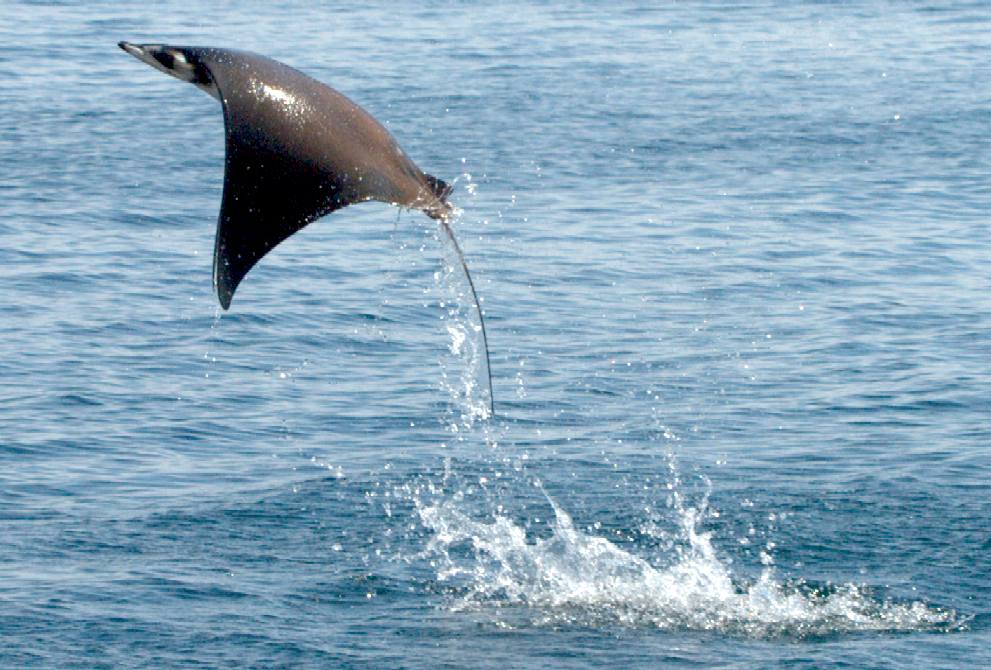
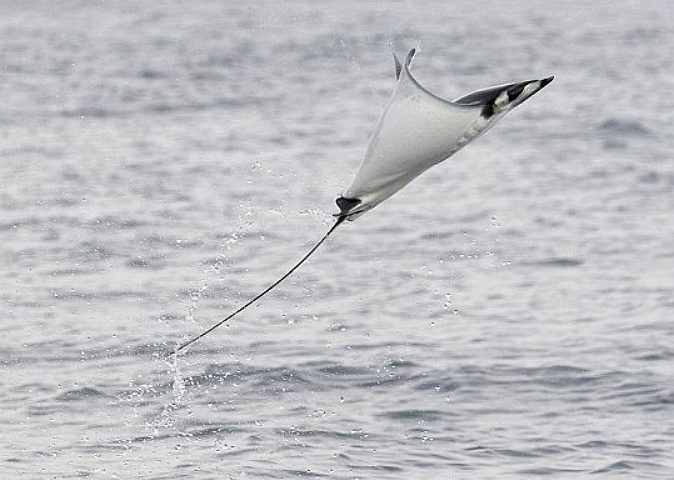
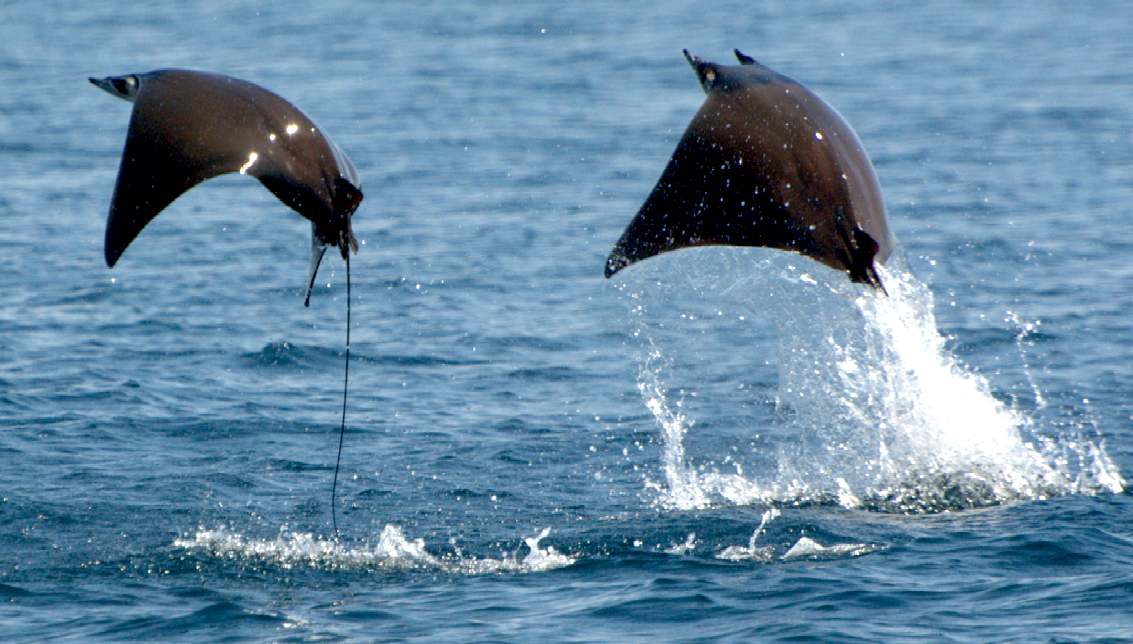
MOBULAS
- Mobula is a genus of ray in the family Myliobatidae (eagle rays). Their appearance is similar to that of manta rays, which are in the same family. Species of this genera are often collectively referred to as "flying
mobula" or simply "flying rays", due to their propensity for breaching, sometimes in a spectacular manner. The devil fish can attain a disc width of up to 5.2 m (17 ft) and can probably weigh over a ton, second only to the Manta species in size. Despite their size, little is known about this genus, much of it being from anecdotal accounts.
The Scripps Institution of Oceanography (sometimes referred to as SIO, Scripps Oceanography, or Scripps) in San Diego, California, founded in 1903, is one of the oldest and largest centers for ocean and Earth science research, public service, undergraduate and graduate training in the world. Hundreds of ocean and Earth scientists conduct research with the aid of oceanographic research vessels and shorebased laboratories. Its Old Scripps Building is a U.S. National Historic Landmark. SIO is a department of the University of California, San Diego. The public explorations center of the institution is the Birch Aquarium at Scripps. Since becoming part of the University of California in 1912, the institution has expanded its scope to include studies of the physics, chemistry, geology, biology, and climate of Earth.
DAILY MAIL 30 JULY 2010 - FLYING GIANTS LEAP 9FT OUT OF THE SEA
They could be mistaken for strange-looking birds but these creatures are actually manta rays, leaping a staggering nine feet in the air.
The plucky animals, which measure just over three feet wide, demonstrate their acrobatic skills by bursting out of the water.
Once airborne they to flap their impressive fins in what looks like an attempt to fly.
And, if they're feeling particularly playful, some even manage a somersault before plummeting back into the water with an impressive splash.
Photographers Roland and Julia Seitre captured the spectacle off the coast of Costa Rica, Central America.
The French couple had sailed six miles out to sea in the hope of catching sight of some whales but were also treated to this extraordinary rare acrobatic display.
Mr Seitre said: 'The males jumped clear out of the water, up to three metres [9ft] high.
'They flapped their wings during the few seconds of flight, before hitting the surface with a loud banging noise.
'Some think it is a way to attract female attention as we saw pairs close by.
'Numerous males take off and land one after another.
'The bangs are so loud it's like you're being close to a hunting party with guns.
'Occasionally one seems to have even more fun by doing a somersault.
'This kind of behaviour is extremely unpredictable and incredibly rare to witness.
'We were so lucky, it was a complete coincidence that we were there in the first place.'
He added: 'These manta rays are beautiful.
'Their large wing-shaped bodies and slow motion make them excellent sea gliders.
'They not only impress with their size but also with their very elegant flight into the blue oceans.'
The manta ray is the largest of the all the rays.
They can grow up to 25ft across and weigh around 5,100lb.
The species are found in tropical waters and feed mostly on plankton, which is filtered into their bodies through their gills as swim.
Perfectly stream-lined for gliding through the water, the manta ray can reach speeds of up to 7mph.
They are often spotted swimming with divers and will sometimes surface alongside boats.
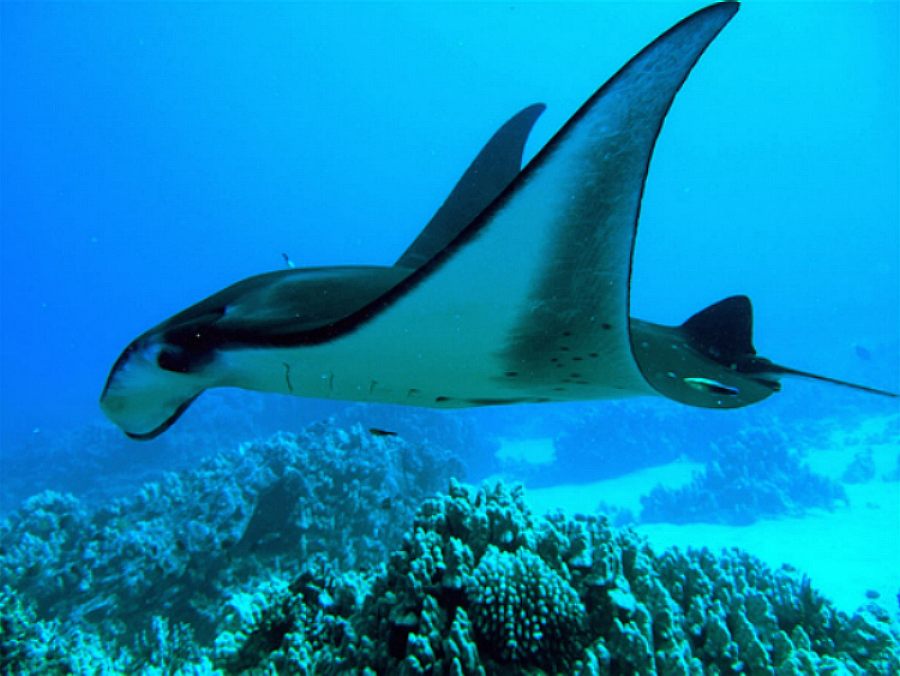
Another
manta gracefully flapping its hydrodynamic wings. As an engineering study,
this giant fish is a marvel of adaptation and efficiency.
LINKS
& REFERENCE
The
power armor cyoa wiki Swarm_Manta-Ray
Geeky
Gadgets underwater robot swims like a manta ray 27-07-2012
KNB
EFX Group
Wired
news archive 2012 July Mantabot
Evologics
subsea glider Aquaray manta robot
Wikipedia_Manta_ray
Wikipedia
list_of_threatened_rays
Studio
Florian projekty Maslovskiy Oleg ocean robotic cleaning system
DailyMail-UK-news
flying-giants-Incredibly-rare-display-manta-rays-leap-3ft-water-air
mantawatch
2012 may the-amazing-jumping-mobulas-of-the-sea-of-cortez
BBC
earth
story 2015 watch these giant rays fly
Wikipedia
Mobula
Wikipedia
Scripps_Institution_of_Oceanography
https://en.wikipedia.org/wiki/Scripps_Institution_of_Oceanography
https://scripps.ucsd.edu/
https://en.wikipedia.org/wiki/Mobula
http://www.bbc.com/earth/story/20150512-watch-these-giant-rays-fly
http://mantawatch.com/site/2012/05/the-amazing-jumping-mobulas-of-the-sea-of-cortez/#.VZM5WVLSMSU
http://www.dailymail.co.uk/news/article-1298362/Flying-giants-Incredibly-rare-display-manta-rays-leap-3ft-water-air.html
http://the-power-armor-cyoa.wikia.com/wiki/File:Swarm_Manta-Ray.jpg
http://www.studioflorian.com/projekty/266-maslovskiy-oleg-ocean-robotic-cleaning-system
http://en.wikipedia.org/wiki/Manta_ray
http://en.wikipedia.org/wiki/List_of_threatened_rays
http://www.evologics.de/en/products/glider/index.html
http://www.wired.co.uk/news/archive/2012-07/25/mantabot
http://www.geeky-gadgets.com/underwater-robot-swims-like-a-manta-ray-27-07-2012/
http://www.knbefxgroup.com/
http://www.telegraph.co.uk/earth/wildlife/8771139/Hollywood-ending-for-dolphins-tale.html
Gawker
job+stealing-robots-are-going-after-the-navys-mine+hunting-dolphins
Quicksilver
Controls 2011_Robotic Dolphin
Independent
Robots to replace navys minehunting dolphins
The
Guardian 2012 US military replace dolphins robots
RUVR
2013 Ukrainian-military-dolphins-go-missing
|
Robot
& Manta Ray
- Youtube
|

KULO
LUNA:
A
heartwarming adventure: pirate whalers
V a wounded whale and three kind people out to save the cetacean, with
a $Billion dollars riding on the conclusion.
ACIDIFICATION
- ADRIATIC
- ARCTIC
- ATLANTIC - BALTIC
- BERING
- CARIBBEAN - CORAL - EAST
CHINA
ENGLISH CH
-
GOC - GULF
MEXICO
- INDIAN
-
IRC - MEDITERRANEAN -
NORTH SEA - PACIFIC
- PERSIAN GULF - SEA
JAPAN
STH
CHINA - PLASTIC
- PLANKTON - PLASTIC
OCEANS - SEA
LEVEL RISE - UNCLOS
- UNEP
WOC
- WWF


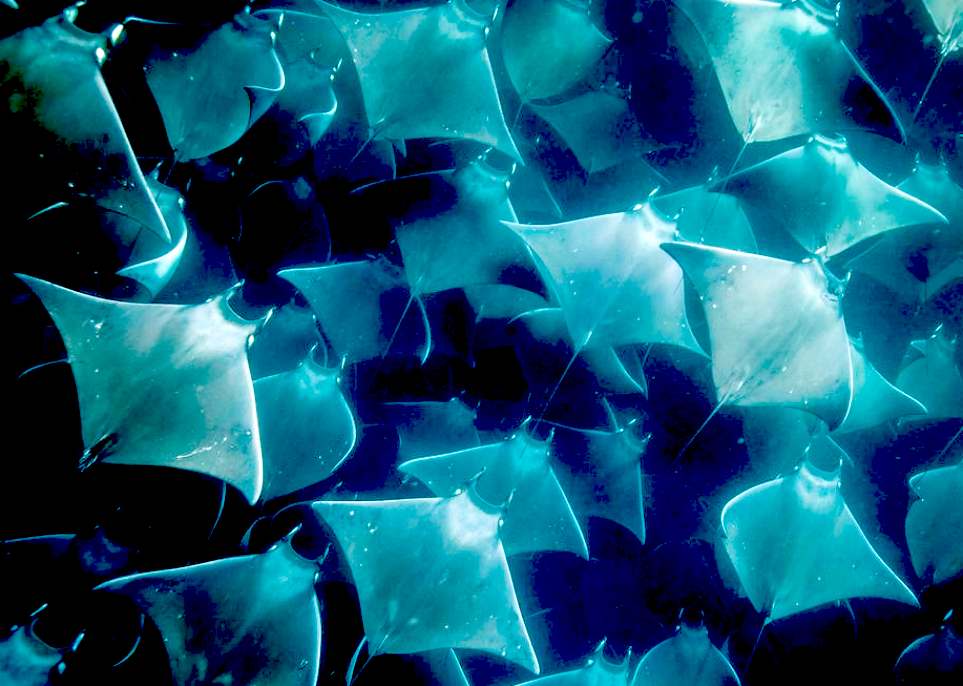
DINOSAURS
- DOLPHINS
- HUMANOIDS
- RAYS
- SHARKS
- WHALES
|

















